Can There be Water Scarcity with Abundance of Water? Analyzing Water Stress during a Severe Drought in Finland
Abstract
1. Introduction
2. Materials and Methods
2.1. Study Area: Finland
2.2. Water Depletion Index
2.3. Data: Water Use
2.3.1. Agriculture
2.3.2. Industry
2.3.3. Public Water Supply
2.3.4. Returned Water
2.4. Data: Reference Drought
2.5. WDI Analysis with Global Models
3. Results
3.1. WDI Results with National Statistics
3.2. WDI Results with Global Models
4. Discussion
4.1. Context-Specific Findings: South and Southwest Finland Most Vulnerable to Drought
4.2. Methodological Findings: WDI Useful for Drought Analysis, Global Analysis has Limitations
4.3. Policy-Relevant Findings: Establishing Drought Management Plans
4.4. Limitations and Ways Forward
5. Conclusions
Supplementary Materials
Author Contributions
Funding
Acknowledgments
Conflicts of Interest
References
- Kummu, M.; Guillaume, J.H.A.; de Moel, H.; Eisner, S.; Flörke, M.; Porkka, M.; Siebert, S.; Ward, P.J. The world’s road to water scarcity: Shortage and stress in the 20th century and pathways towards sustainability. Sci. Rep. 2016, 6, 38495. [Google Scholar] [CrossRef]
- Cook, C.; Bakker, K. Water security: Debating an emerging paradigm. Glob. Environ. Chang. 2012, 22, 94–102. [Google Scholar] [CrossRef]
- Ministry for Foreign Affairs of Finland; Ministry of Agriculture and Forestry; Ministry of the Environment; Ministry of Social Affairs and Health; Ministry of Economic Affairs and Employment. International Water Strategy Finland; Ministry for Foreign Affairs: Helsinki, Finland, 2018.
- Zeitoun, M.; Lankford, B.; Krueger, T.; Forsyth, T.; Carter, R.; Hoekstra, A.Y.; Taylor, R.; Varis, O.; Cleaver, F.; Boelens, R.; et al. Reductionist and integrative research approaches to complex water security policy challenges. Glob. Environ. Chang. 2016, 39, 143–154. [Google Scholar] [CrossRef]
- Varis, O.; Keskinen, M.; Kummu, M. Four dimensions of water security with a case of the indirect role of water in global food security. Water Secur. 2017, 1, 36–45. [Google Scholar] [CrossRef]
- UN-Water. Water Security and the Global Water Agenda: A UN-Water Analytical Brief; UN-Water Analytical Brief; United Nations University—Institute for Water, Environment and Health: Tokyo, Japan, 2013. [Google Scholar]
- World Economic Forum. Global Risks 2011, 6th ed.; Council on Foreign Relations: New York, NY, USA, 2011. [Google Scholar]
- Bazilian, M.; Rogner, H.; Howells, M.; Hermann, S.; Arent, D.; Gielen, D.; Steduto, P.; Mueller, A.; Komor, P.; Tol, R.S.J.; et al. Considering the energy, water and food nexus: Towards an integrated modelling approach. Energy Policy 2011, 39, 7896–7906. [Google Scholar] [CrossRef]
- Hoff, H. Understanding the nexus. In Bonn 2011 Conference, The Water, Energy and Food Security Nexus: Solutions for the Green Economy, Bonn, Germany; Stockholm Environment Institute: Stockholm, Sweden, 2011. [Google Scholar]
- Keskinen, M.; Guillaume, J.; Kattelus, M.; Porkka, M.; Räsänen, T.; Varis, O. The Water-Energy-Food Nexus and the Transboundary Context: Insights from Large Asian Rivers. Water 2016, 8, 193. [Google Scholar] [CrossRef]
- Guppy, L.; Mehta, P.; Qadir, M. Sustainable development goal 6: Two gaps in the race for indicators. Sustain. Sci. 2019, 14, 501–513. [Google Scholar] [CrossRef]
- Hussein, H.; Menga, F.; Greco, F. Monitoring Transboundary Water Cooperation in SDG 6.5.2: How a Critical Hydropolitics Approach Can Spot Inequitable Outcomes. Sustainability 2018, 10, 3640. [Google Scholar] [CrossRef]
- Global Water Partnership Central Easter Europe. Guidelines for the preparation of Drought Management Plans. Development and implementation in the Context of the EU Water Framework Directive; Global Water Partnership Central and Eastern Europe: Bratislava, Slovakia, 2015; p. 48. [Google Scholar]
- European Commission. Drought Management Plan Report: Including Agricultural, Drought Indicators and Climate Change Aspects; European Commission: Brussels, Belgium, 2008. [Google Scholar]
- Silander, J.; Järvinen, E.A. Vuosien 2002–2003 Poikkeuksellisen Kuivuuden Vaikutukset; Suomen Ympäristö 731; Finnish Environment Institute: Helsinki, Finland, 2004.
- Jääskeläinen, J.; Veijalainen, N.; Syri, S.; Marttunen, M.; Zakeri, B. Energy security impacts of a severe drought on the future Finnish energy system. J. Environ. Manag. 2018, 217, 542–554. [Google Scholar] [CrossRef]
- Spinoni, J.; Vogt, J.V.; Naumann, G.; Barbosa, P.; Dosio, A. Will drought events become more frequent and severe in Europe? Int. J. Climatol. 2018, 38, 1718–1736. [Google Scholar] [CrossRef]
- Natural Resources Institute Finland Press Release: Viljasato yhtä pieni kuin 20 vuotta sitten. (In Finnish). Available online: https://www.luke.fi/uutiset/viljasato-yhta-pieni-kuin-20-vuotta-sitten/ (accessed on 20 December 2018).
- Tsakiris, G. Proactive Planning Against Droughts. Procedia Eng. 2016, 162, 15–24. [Google Scholar] [CrossRef]
- Xu, H.; Wu, M. Water Availability Indices—A Literature Review; Argonne National Lab.: Argonne, IL, USA, 2017. [CrossRef]
- Brown, A.; Matlock, M.D. A review of water scarcity indices and methodologies. White Paper 2011, 106, 19. [Google Scholar]
- Rijsberman, F.R. Water scarcity: Fact or fiction? Agric. Water Manag. 2006, 80, 5–22. [Google Scholar] [CrossRef]
- Wada, Y.; Beek, L.P.H.; van Viviroli, D.; Dürr, H.H.; Weingartner, R.; Bierkens, M.F.P. Global monthly water stress: II. Water demand and severity of water. Water Resour. Res. 2011, 47. [Google Scholar] [CrossRef]
- Brauman, K.A.; Richter, B.D.; Postel, S.; Malsy, M.; Flörke, M. Water depletion: An improved metric for incorporating seasonal and dry-year water scarcity into water risk assessments. Elem. Sci. Anth. 2016. [Google Scholar] [CrossRef]
- European Environment Agency. Results and Lessons from Implementing the Water Assets Accounts in the EEA Area; European Environment Agency: Copenhagen, Denmark, 2013. [Google Scholar]
- Damkjaer, S.; Taylor, R. The measurement of water scarcity: Defining a meaningful indicator. Ambio 2017, 46, 513–531. [Google Scholar] [CrossRef]
- Warszawski, L.; Frieler, K.; Huber, V.; Piontek, F.; Serdeczny, O.; Schewe, J. The inter-sectoral impact model intercomparison project (ISI–MIP): Project framework. Proc. Natl. Acad. Sci. USA 2014, 111, 3228–3232. [Google Scholar] [CrossRef]
- Smakhtin, V.; Revenga, C.; Döll, P. A Pilot Global Assessment of Environmental Water Requirements and Scarcity. Water Int. 2004, 29, 307–317. [Google Scholar] [CrossRef]
- Veijalainen, N.; Dubrovin, T.; Marttunen, M.; Vehviläinen, B. Climate Change Impacts on Water Resources and Lake Regulation in the Vuoksi Watershed in Finland. Water Resour. Manag. 2010, 24, 3437–3459. [Google Scholar] [CrossRef]
- Richts, A.; Vrba, J. Groundwater resources and hydroclimatic extremes: Mapping global groundwater vulnerability to floods and droughts. Environ. Earth Sci. 2016, 75, 926. [Google Scholar] [CrossRef]
- Pajula, H.; Triipponen, J. Selvitys Suomen Kastelutilanteesta–Esimerkkialueena Varsinais-Suomi; Suomen Ympäristö 629; Finnish Environment Institute: Helsinki, Finland, 2003.
- Lai, T.; Salminen, J.; Jäppinen, J.; Koljonen, S.; Mononen, L.; Nieminen, E.; Vihervaara, P.; Oinonen, S. Bridging the gap between ecosystem service indicators and ecosystem accounting in Finland. Ecol. Model. 2018, 377, 51–65. [Google Scholar] [CrossRef]
- Mustonen, S. Sovellettu Hydrologia; Vesiyhdistys r.y: Mänttä, Finland, 1986; p. 503. [Google Scholar]
- Pirinen, P.; Simola, H.; Aalto, J.; Kaukoranta, J.; Karlsson, P.; Ruuhela, R. Climatological statistics of Finland 1981–2010 Reports 2012:1; Finnish Meteorological Institute: Helsinki, Finland, 2012.
- Helminen, V.; Nurmio, K.; Rehunen, A.; Ristimäki, M.; Oinonen, K.; Tiitu, M.; Kotavaara, O.; Antikainen, H.; Rusanen, J. Urban—Rural Classification; Suomen Ympäristökeskuksen Raportteja 25/2014; Suomen Ympäristökeskuksen: Helsinki, Finland, 2014.
- Scherer, L.; Venkatesh, A.; Karuppiah, R.; Pfister, S. Large-Scale Hydrological Modeling for Calculating Water Stress Indices: Implications of Improved Spatiotemporal Resolution, Surface-Groundwater Differentiation, and Uncertainty Characterization. Environ. Sci. Technol. 2015, 49, 4971–4979. [Google Scholar] [CrossRef]
- Perry, C. Efficient irrigation; inefficient communication; flawed recommendations. Irrig. Drain. 2007, 56, 367–378. [Google Scholar] [CrossRef]
- Huttunen, M.; Vehviläinen, B. Hydrological Forecasting and Real Time Monitoring in Finland: The Watershed Simulation and Forecasting System (WSFS); The Finnish Environment Institute: Helsinki, Finland, 2001. [CrossRef]
- Vehviläinen, B.; Huttunen, M.; Huttunen, I. Hydrological forecasting and real time monitoring in finland: The watershed simulation and forecasting system (WSFS). In Proceedings of the Achieving Technological Innovation in Flood Forecasting: International conference on innovation, advances and implementation of flood forecasting technology, Tromso, Norway, 17–19 October 2005; Conference papers. p. 100. [Google Scholar]
- Mehta, L. The Manufacture of Popular Perceptions of Scarcity: Dams and Water-Related Narratives in Gujarat, India. World Dev. 2001, 29, 2025–2041. [Google Scholar] [CrossRef]
- Mehta, L. Water and Human Development. World Dev. 2014, 59, 59–69. [Google Scholar] [CrossRef]
- Edwards, G.A.S. Shifting Constructions of Scarcity and the Neoliberalization of Australian Water Governance. Environ. Plan. A 2013, 45, 1873–1890. [Google Scholar] [CrossRef]
- Hussein, H. Whose ‘reality’? Discourses and hydropolitics along the Yarmouk River. Contemp. Levant 2017, 2, 103–115. [Google Scholar] [CrossRef]
- Mdee, A. Disaggregating Orders of Water Scarcity—The Politics of Nexus in the Wami-Ruvu River Basin, Tanzania. Water Altern. 2017, 10, 100. [Google Scholar]
- Hussein, H. Lifting the veil: Unpacking the discourse of water scarcity in Jordan. Environ. Sci. Policy 2018, 89, 385–392. [Google Scholar] [CrossRef]
- VisitFinland. Land of a Thousand Lakes. Available online: https://www.visitfinland.com/article/the-water-of-life/ (accessed on 7 March 2019).
- Acreman, M.C.; Dunbar, M.J. Defining environmental river flow requirements? A review. Hydrol. Earth Syst. Sci. Discuss. 2004, 8, 861–876. [Google Scholar] [CrossRef]
- Sood, A.; Smakhtin, V. Global hydrological models: A review. Hydrol. Sci. J. 2015, 60, 549–565. [Google Scholar] [CrossRef]
- Bêche, L.A.; Connors, P.G.; Resh, V.H.; Merenlender, A.M. Resilience of fishes and invertebrates to prolonged drought in two California streams. Ecography 2009, 32, 778–788. [Google Scholar] [CrossRef]
- Bond, N.R.; Lake, P.S.; Arthington, A.H. The impacts of drought on freshwater ecosystems: An Australian perspective. Hydrobiologia 2008, 600, 3–16. [Google Scholar] [CrossRef]
- Mekonnen, M.M.; Hoekstra, A.Y. Global Anthropogenic Phosphorus Loads to Freshwater and Associated Grey Water Footprints and Water Pollution Levels: A High-Resolution Global Study. Water Resour. Res. 2018, 54, 345–358. [Google Scholar] [CrossRef]
- Vienonen, S.; Rintala, J.; Orvomaa, M.; Santala, E.; Maunula, M. Ilmastonmuutoksen Vaikutukset ja Sopeutumistarpeet Vesihuollossa; Suomen ympäristö 24/2012; Finnish Environment Institute: Helsinki, Finland, 2012.
- Kampbell, D.H.; An, Y.; Jewell, K.P.; Masoner, J.R. Groundwater quality surrounding Lake Texoma during short-term drought conditions. Environ. Pollut. 2003, 125, 183–191. [Google Scholar] [CrossRef]
- Salmivaara, A.; Porkka, M.; Kummu, M.; Keskinen, M.; Guillaume, H.J.; Varis, O. Exploring the Modifiable Areal Unit Problem in Spatial Water Assessments: A Case of Water Shortage in Monsoon Asia. Water 2015, 7, 878. [Google Scholar] [CrossRef]
- Ekholm, M. Suomen Vesistöalueet. In Vesi- ja Ympäristöhallinnon Julkaisuja—Sarja A 126; Vesi ja Ympäristöhallitus: Helsinki, Finland, 1993. [Google Scholar]
- Hoekstra, A.Y.; Mekonnen, M.; Chapagain, A.; Mathews, R.E.; Richter, B.D. Global monthly water scarcity: Blue water footprints versus blue water availability. PLoS ONE 2012, 7, e32688. [Google Scholar] [CrossRef]
- Alcamo, J.; Döll, P.; Henrichs, T.; Kaspar, F.; Lehner, B.; Rösch, T.; Siebert, S. Development and testing of the WaterGAP 2 global model of water use and availability. Hydrol. Sci. J. 2003, 48, 317–337. [Google Scholar]
- Sorvala, S.; Puumala, M.; Lehto, M. Käyttöveden Riittävyys ja Laatu Maatalouden Suurissa Tuotantoyksiköissä; MTT: Vihti, Finland, 2006. [Google Scholar]
- Natural Resources Institute Finland. Official Statistics of Finland (OSF): Farmland Management and Irrigation 2016. Available online: https://stat.luke.fi/en/farmland-management-and-irrigation (accessed on 19 December 2018).
- Rey, D.; Holman, I.P.; Daccache, A.; Morris, J.; Weatherhead, E.K.; Knox, J.W. Modelling and mapping the economic value of supplemental irrigation in a humid climate. Agric. Water Manag. 2016, 173, 13–22. [Google Scholar] [CrossRef]
- Huttunen, I.; Huttunen, M.; Piirainen, V.; Korppoo, M.; Lepistö, A.; Räike, A.; Tattari, S.; Vehviläinen, B. A national-scale nutrient loading model for Finnish watersheds—VEMALA. Environ. Model. Assess. 2016, 21, 83–109. [Google Scholar] [CrossRef]
- Tahvonen, R.; Kaukoranta, T.; Väisänen, J.; Salo, T. Peltotohtori Neuvoo Viljelyssä; Maaseudun tulevaisuus: Vihti, Finland, 2003. [Google Scholar]
- Solley, W.B.; Pierce, R.R.; Perlman, H.A. Estimated Use of Water in the United States in 1995; U.S. Geological Survey Circular 1200; U.S. Department of the Interior and U.S. Geological Survey: Reston, VA, USA, 1998; p. 86. Available online: https://pubs.er.usgs.gov/publication/cir1200 6.6.2018 (accessed on 6 May 2018).
- Dieter, C.A.; Maupin, M.A.; Caldwell, R.R.; Harris, M.A.; Ivahnenko, T.I.; Lovelace, J.K.; Barber, N.L.; Linsey, K.S. Estimated Use of Water in the United States in 2015; U.S. Geological Survey Circular 1441; U.S. Department of the Interior and U.S. Geological Survey: Reston, VA, USA, 2018; p. 65. [CrossRef]
- Kuusisto, E. The Water Cycle, Hydrological service in Finland 1908–2008; Finnish Environment Institute: Helsinki, Finland, 2008; p. 176.
- Veijalainen, N.; Ahopelto, L.; Marttunen, M.; Jääskeläinen, J.; Britschgi, R.; Orvomaa, M.; Belinskij, A.; Keskinen, M. Severe drought in Finland: Modeling effects on water resources and assessing climate change impacts. 2019; in review. [Google Scholar]
- Mikkonen, S.; Laine, M.; Mäkelä, H.; Gregow, H.; Tuomenvirta, H.; Lahtinen, M.; Laaksonen, A. Trends in the average temperature in Finland, 1847–2013. Stoch. Environ. Res. Risk Assess. 2015, 29, 1521–1529. [Google Scholar] [CrossRef]
- Veijalainen, N.; Lotsari, E.; Alho, P.; Vehviläinen, B.; Käyhkö, J. National scale assessment of climate change impacts on flooding in Finland. J. Hydrol. 2010, 391, 333–350. [Google Scholar] [CrossRef]
- Gosling, S.; Müller Schmied, H.; Betts, R.; Chang, J.; Ciais, P.; Dankers, R.; Döll, P.; Eisner, S.; Flörke, M.; Gerten, D.; et al. ISIMIP2a Simulation Data from Water (global) Sector. GFZ Data Services, 2017. [Google Scholar] [CrossRef]
- Döll, P.; Lehner, B. Validation of a new global 30-min drainage direction map. J. Hydrol. 2002, 258, 214–231. [Google Scholar] [CrossRef]
- Finnish Environment Institute. Press Release (In Finnish): Lounais-, Länsi- ja Keski-Suomessa Pohjaveden Pinnat Alhaalla, Yksittäisissä Kaivoissa vesi voi Kevääseen Mennessä Loppua. Available online: http://www.syke.fi/fi-FI/Ajankohtaista/Lounais_Lansi_ja_KeskiSuomessa_pohjavede%2848557%29 (accessed on 20 December 2018).
- Porkka, M.; Guillaume, J.H.A.; Siebert, S.; Schaphoff, S.; Kummu, M. The use of food imports to overcome local limits to growth. Earth’s Future 2017, 5, 393–407. [Google Scholar] [CrossRef]
- Ministry of Agriculture and Forestry. Finland’s National Climate Change Adaptation Plan 2022; Ministry of Agriculture and Forestry: Wellington, New Zealand, 2014; p. 42.
- Sojamo, S.; Ahopelto, L.; Marttunen, M.; Belinskij, A.; Veijalainen, N.; Keskinen, M. Water security—What does it mean for Finland? Vesitalous 2017, 6, 20–24. (In Finnish) [Google Scholar]
- Aaltonen, J.; Parjanne, A.; Huokuna, M. Implementation of EU Floods Directive in Finland—Lessons Learned ans Steps towards Resilient Planning. 2017. Available online: https://www.ymparisto.fi/download/noname/%7BD63A26CB-33EC-4E85-85EC-EA4B3837E93C%7D/132735 (accessed on 13 March 2019).
- Tortajada, C.; Kastner, M.J.; Buurman, J.; Biswas, A.K. The California drought: Coping responses and resilience building. Environ. Sci. Policy 2017, 78, 97–113. [Google Scholar] [CrossRef]
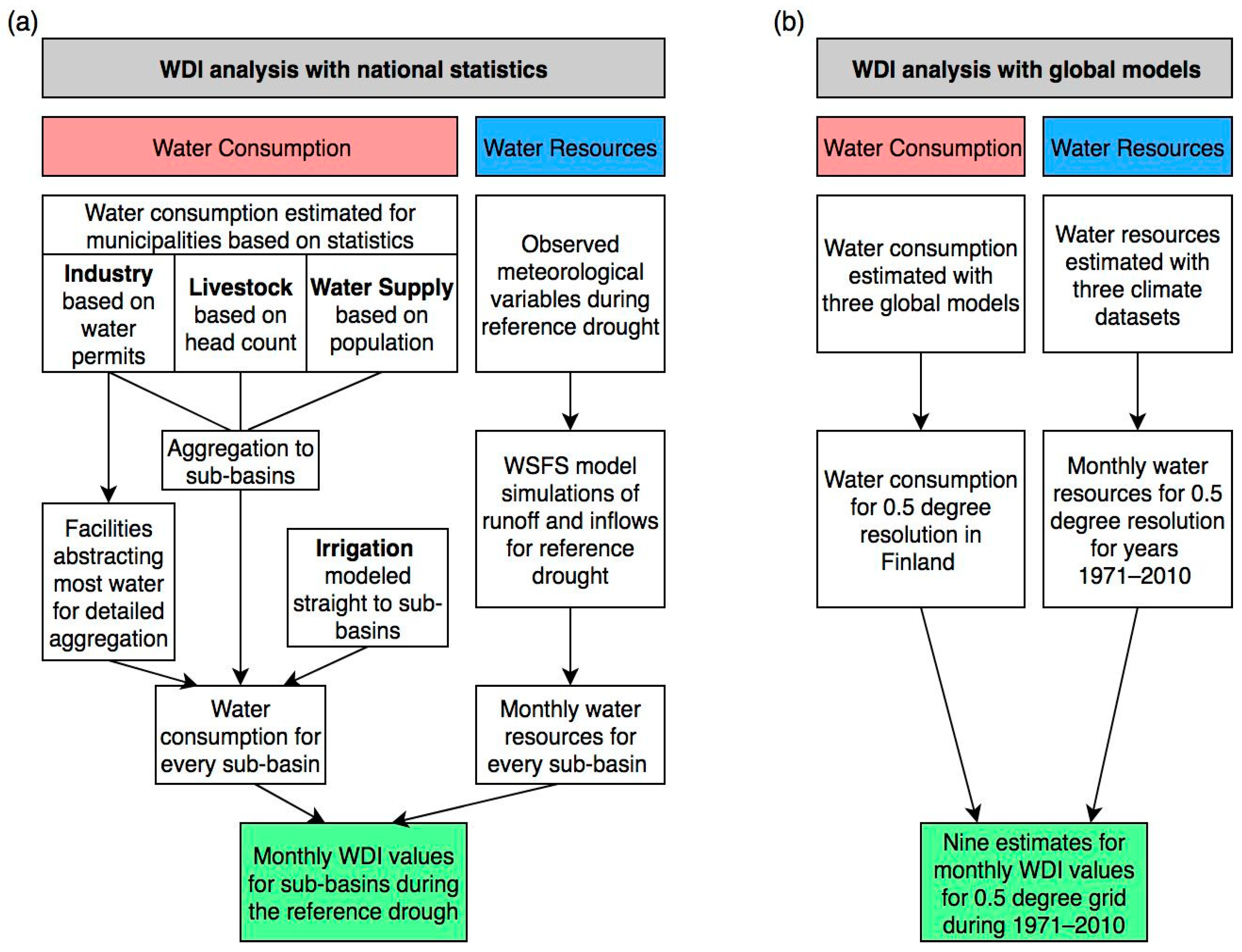
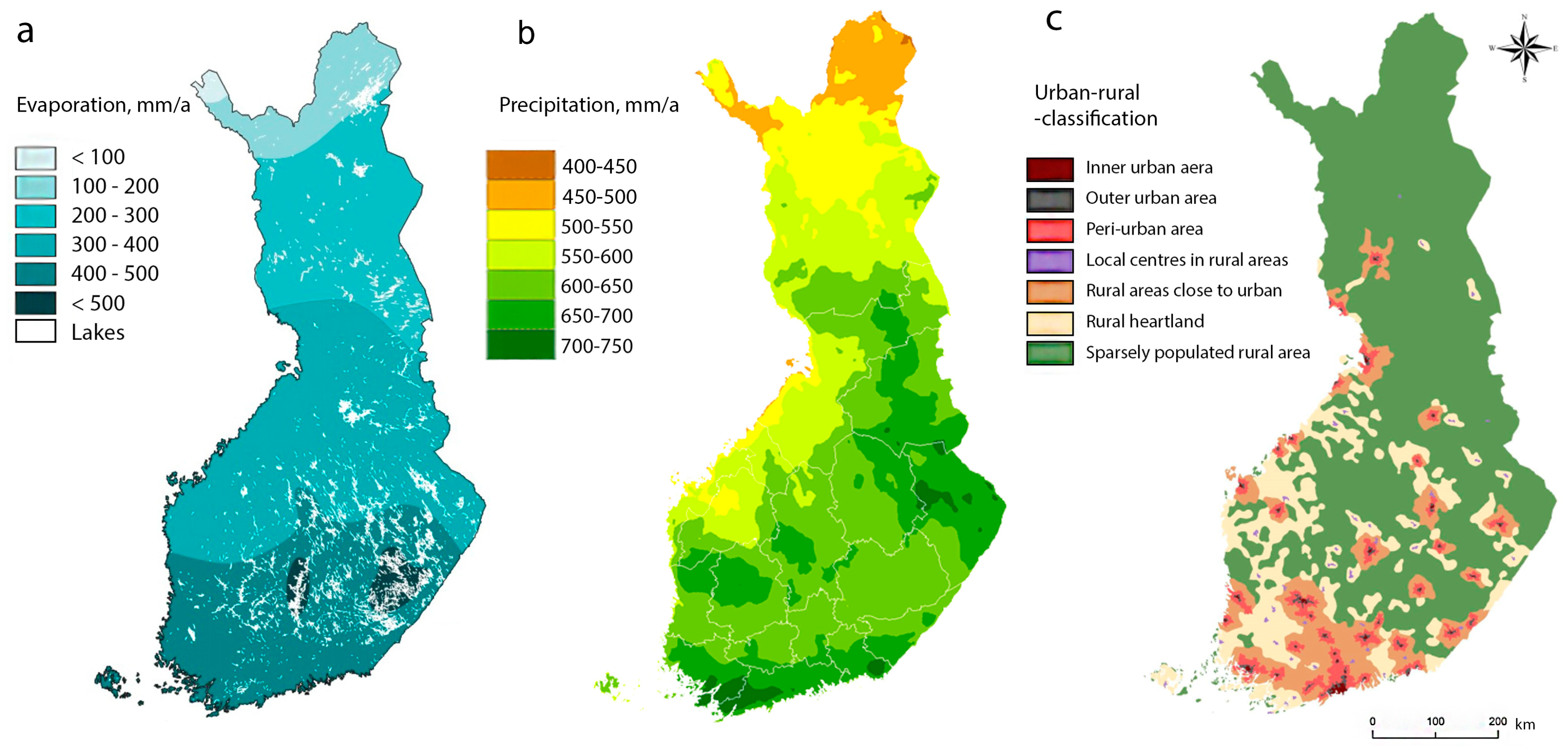

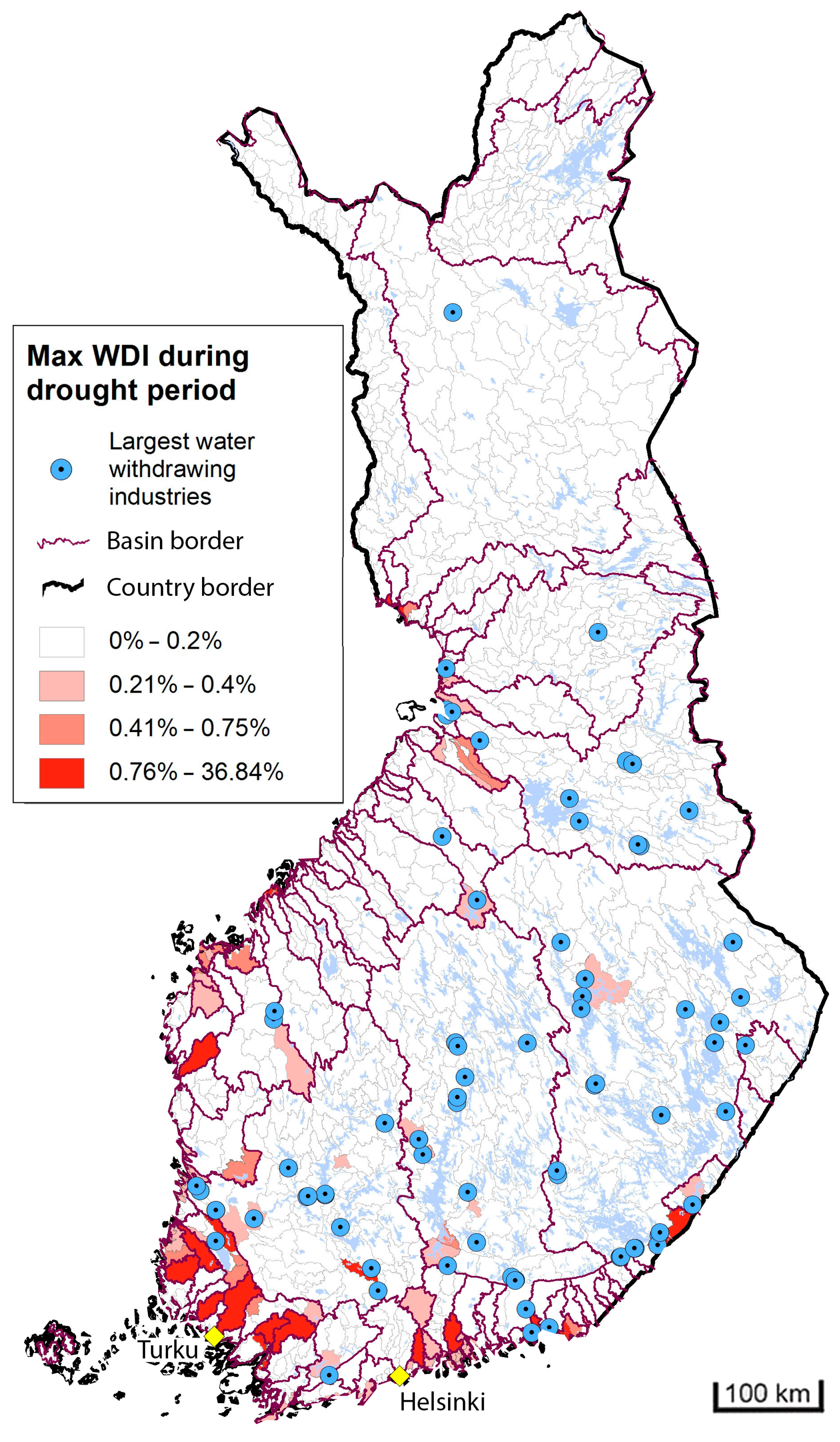
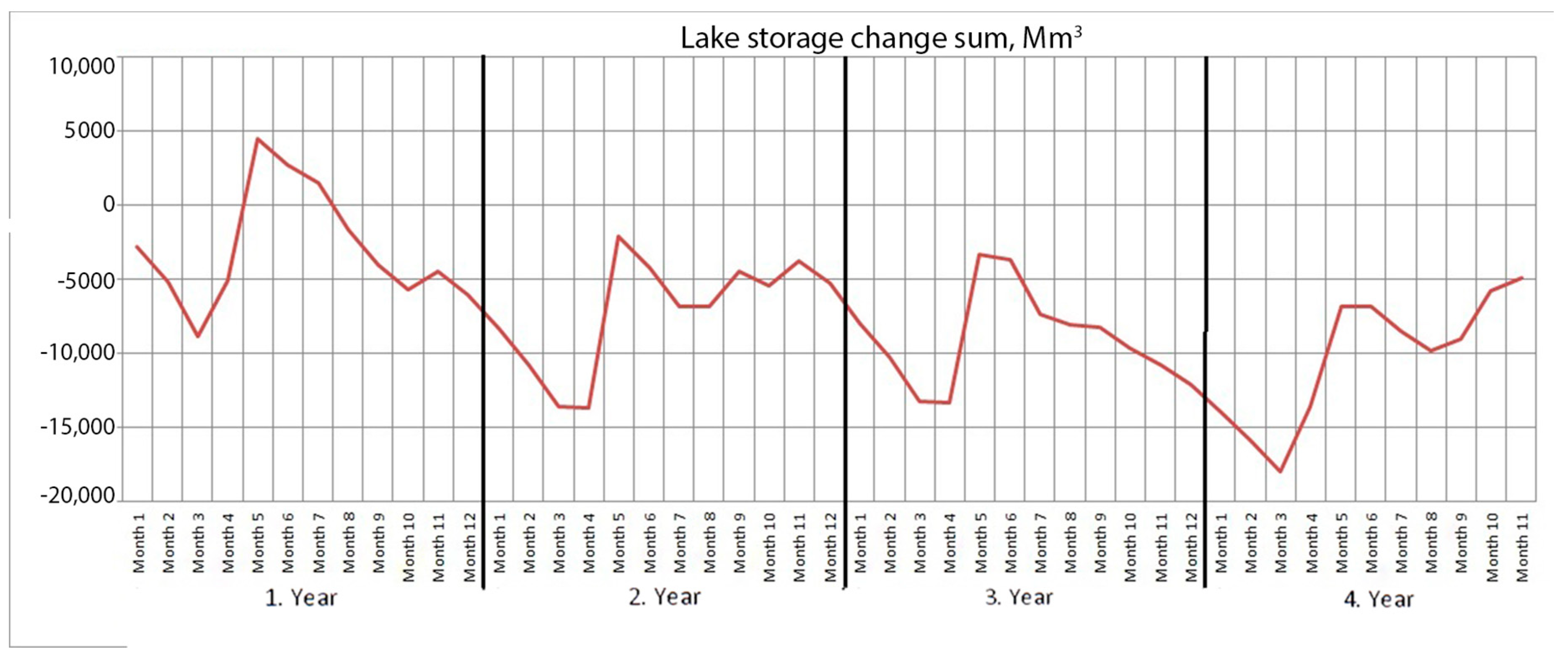
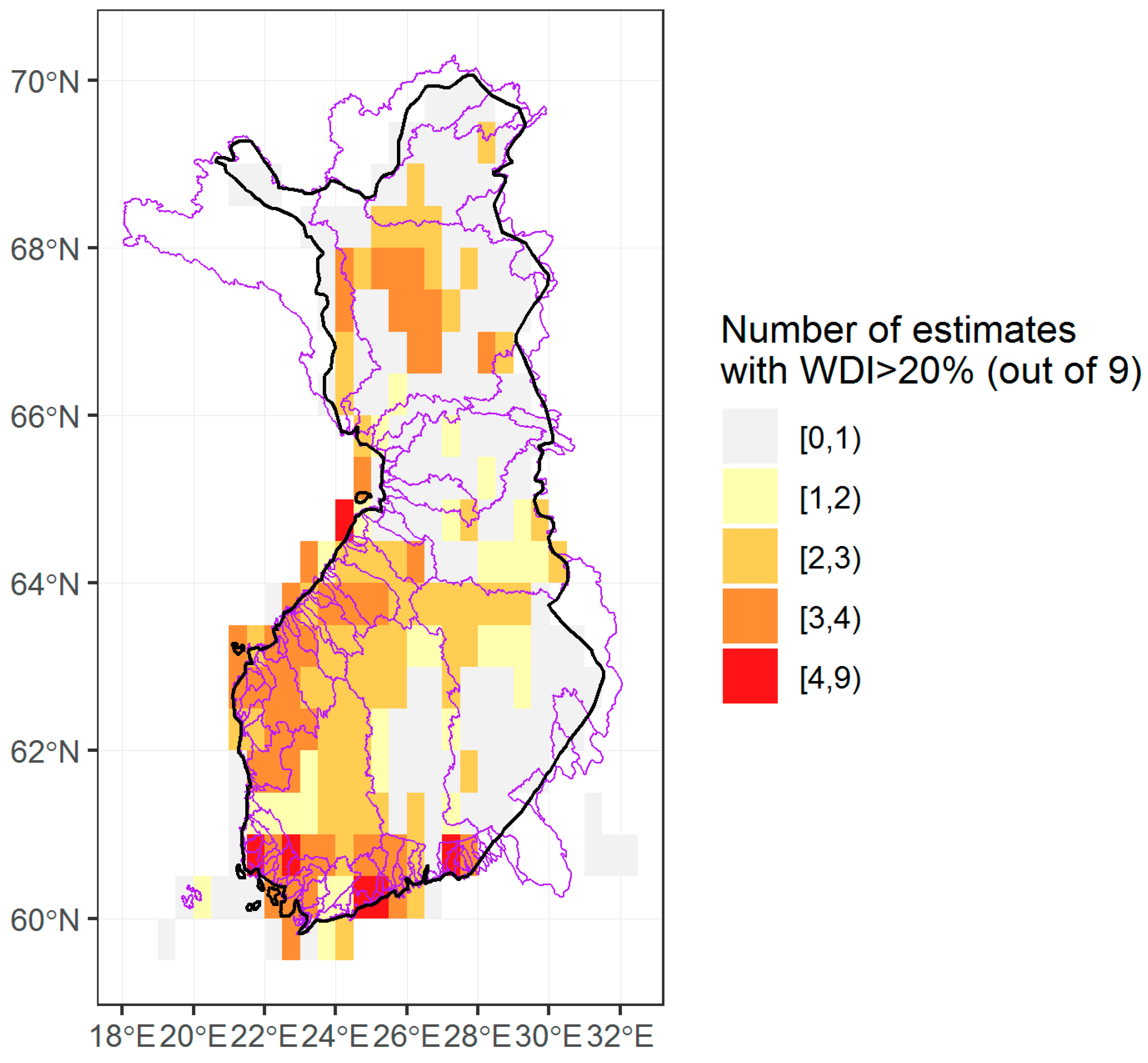
© 2019 by the authors. Licensee MDPI, Basel, Switzerland. This article is an open access article distributed under the terms and conditions of the Creative Commons Attribution (CC BY) license (http://creativecommons.org/licenses/by/4.0/).
Share and Cite
Ahopelto, L.; Veijalainen, N.; Guillaume, J.H.A.; Keskinen, M.; Marttunen, M.; Varis, O. Can There be Water Scarcity with Abundance of Water? Analyzing Water Stress during a Severe Drought in Finland. Sustainability 2019, 11, 1548. https://doi.org/10.3390/su11061548
Ahopelto L, Veijalainen N, Guillaume JHA, Keskinen M, Marttunen M, Varis O. Can There be Water Scarcity with Abundance of Water? Analyzing Water Stress during a Severe Drought in Finland. Sustainability. 2019; 11(6):1548. https://doi.org/10.3390/su11061548
Chicago/Turabian StyleAhopelto, Lauri, Noora Veijalainen, Joseph H. A. Guillaume, Marko Keskinen, Mika Marttunen, and Olli Varis. 2019. "Can There be Water Scarcity with Abundance of Water? Analyzing Water Stress during a Severe Drought in Finland" Sustainability 11, no. 6: 1548. https://doi.org/10.3390/su11061548
APA StyleAhopelto, L., Veijalainen, N., Guillaume, J. H. A., Keskinen, M., Marttunen, M., & Varis, O. (2019). Can There be Water Scarcity with Abundance of Water? Analyzing Water Stress during a Severe Drought in Finland. Sustainability, 11(6), 1548. https://doi.org/10.3390/su11061548




